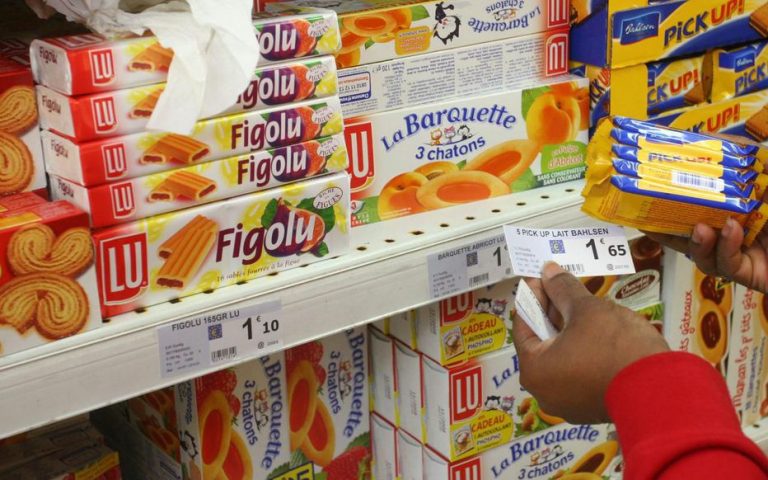With the development of artificial intelligence, the retail industry has undergone a number of technological innovations in recent years. Among these changes, electronic shelf labels (ESL) have replaced traditional paper labels and have now become a standard solution for new retail businesses.
When comparing traditional labels to electronic labels, what benefits does this technological innovation bring to retailers?
Adhesive paper price labels
In order to comply with price labeling laws and meet consumer expectations, retailers must now be transparent about product pricing and information. Of course, paper labeling is less expensive in terms of acquisition to manage operations, but it can be very expensive in terms of return on investment. There are several drawbacks to paper price labeling:

Limited use forms
Its degradation over time due to humidity as well as the inconvenience to put it on food shelves such as frozen or fresh products section.
Ineffective price update
The time spent for manufacturing and renewing paper label during price changes or when a flyer comes out highlighting promotions. In fact, the process of changing (removing then re-sticking)one paper label can take up to two minutes, which greatly affects the efficiency and productivity in addition to increasing the chances of posting delayed prices, and/or inaccurate prices. As a result, using traditional paper labels means running the risk of frequent pricing errors, between 5 and 10% of prices on average.
Customer dissatisfaction due to pricing errors
A greater risk of error and price incoherence between the picking on the shelf and the checkout, which leads to customer frustration and loss of profitability for the retailer since he must grant compensation to customer in case of price difference for a product according to the accuracy policy price. A study highlighted an error rate of 8% between the price paid by the consumer and the displayed price and in 51% of cases the price difference was in favor of the consumer.
Negative impact on the environment
The ecological aspect is at stake. In fact, each price change with traditional paper labels requires a large production of paper, which is harmful to the environment. Paper price labels produce nearly 120,000 tonnes of waste per year, which contributes to a significant increase in the CO2 footprint.
Changing paper labels: a time-consuming and expensive task
Fluctuating product prices require constant updating of prices in-store. The manual change of paper labels is a time consuming task which is not only laborious but also very tedious for the employee. Moreover, in order to perform this daily task, retailers need additional labor: they hire staff specifically dedicated to installing labels on the shelves. This becomes costly after a while since this additional manpower does not represent added value in the eyes of retailers nor in the eyes of customers.
Pricer’s Instant SmartFLASH electronic shelf labels
Electronic shelf labels have revolutionized the operations of the retail industry, improving both price and inventory management, in-store information and the shopping experience.
Centralized information control
Pricer electronic shelf labels are able to communicate clearly and precisely all the information sought by a customer or an employee. This optimal communication is done through an infrared connection which allows information to be transmitted at high speed and update prices instantly. In fact, the price and information of the product are entered only once in the system database and are then directly sent to all the ESL of the stores. Quickly updating prices allows retailers to avoid pricing errors and have better inventory management while remaining competitive on the market. Likewise, controlling products in stock allows for better performance in terms of promotions.
Time saving
To reduce the number of errors, retailers are shifting away from traditional paper labels to digital price labels with infrared optical communication. “With this labeling sytem, we only have two or three corrections to make per week” explains Philippe Collet, Head of Sector of a large European food chain, Carrefour. And it only takes a few minutes to change the prices on all electronic shelf labels. “Before, this operation took us four to five days.”
Eco-friendly solution
Unlike the heavy ecological footprint of traditional paper labels, with electronic shelf labels this problem is smaller. In fact, instead of changing and destroying adhesive paper labels every time an update is needed, Pricer ESL enable retailers to change prices easily, and in real time for at least ten years. In addition, ESL have low power consumption with long-lasting batteries. Once the battery is used up, the old ESL are recycled, reducing the carbon footprint of retailers.
“Electronic shelf labels were chosen for ecological reasons” declares Geneviève Gagnon, Vice-president of Gagnon La Grande Quincaillerie.

Precise, dynamic and attractive displays
Unlike paper labels which have a limited display capacity, Pricer graphic electronic shelf labels can display a lot of essential information in real time (dates of promotions, out-of-stock, orders status), and can resist to extreme temperatures. (-25 ° C – +40 ° C). Furthermore, a buyer will be able to quickly identify a product in promotion from the colors and images displayed on the Pricer graphic ESL, allowing them to save time in their search for information. This not only speeds up the purchasing process but also enhances the products on the shelf.
Qualitative customer service and shopping experience
Electronic shelf labels are the solution to manual mistakes made with paper labels, saving time for both staff and customers. Employees can optimize their work and devote more time to customer inquiries, resulting in better customer service within the retail space. In fact, in addition to being assisted by the information displayed on the ESL or by a clerk, buyers will also have access to support services that accelerate their purchasing process:
- Geolocation: This system helps customers find their way around the stores. They will be able to follow an automated route on a store map, making it easier to find the product they are looking for in a matter of seconds. Geolocation is also useful for employees when it comes to restocking shelves.
- Click & Collect: With our Pricer Instant Flash solution, the order picker can find the product faster. Indeed, electronic labels and instant flash facilitate and accelerate product collection by up to 50%.
Conclusion – Pricer electronic shelf labels are the perfect solution to all the inconveniences a retailer can have when using traditional paper labels. This innovative technology is improving all forms of in-store operations. ESL ensure customer satisfaction, increased productivity and profitability in stores, and better inventory management.

